Các bạn đang học IELTS và cần tài liệu Writing để luyện thi? Ngoài việc ôn tập thật kỹ kiến thức thì việc tham khảo những bài mẫu IELTS Writing cũng giúp chúng ta rất nhiều trong việc luyện viết. Trong bài viết này, Vietop English gửi đến bạn tổng hợp các bài mẫu IELTS Writing 2017 kèm đáp án chi tiết. Mời các bạn tham khảo qua nhé!
Bài mẫu IELTS Writing Task 1 năm 2017
Ngày 25/02/2017
Task 1: The chart illustrates the population size, death rate, birth rate in England and Wales from 1700 to 2000?

Sample answer
The bar charts given shed light on two noticeable features concerning the population, mortality rates and birth rates of part of Great Britain (namely, England and Wales) over the 1700-2000 period.
Firstly, in terms of population growth, there was a crystal-clear upward trend. From only 3 million people in 1700, the population rose considerably over the centuries: 11 million (in 1800), 32 million (in 1900) and 50 million (in 2000). Compared with the beginning of the 18th century, the start of the 21st century experienced nearly a seventeenfold increase.
Secondly, the rates of birth were always higher than the rates of death. Specifically, in 1800, these figures (30% and 25% respectively) were significantly higher than those in 1700 (10% and 6% respectively). After that, however, the figures fell dramatically: 16% and 12% (in 1900); 16% and 4% (in 2000). The death rate in 2000 was even lower than that in 1700.
Overall, despite fluctuations in birth and mortality rates, the total population of England and Wales increased remarkably from 1700 to 2000.
Ngày 04/03/2017
Task 1: The maps below show information about the change of Riverage college 30 years ago and now.
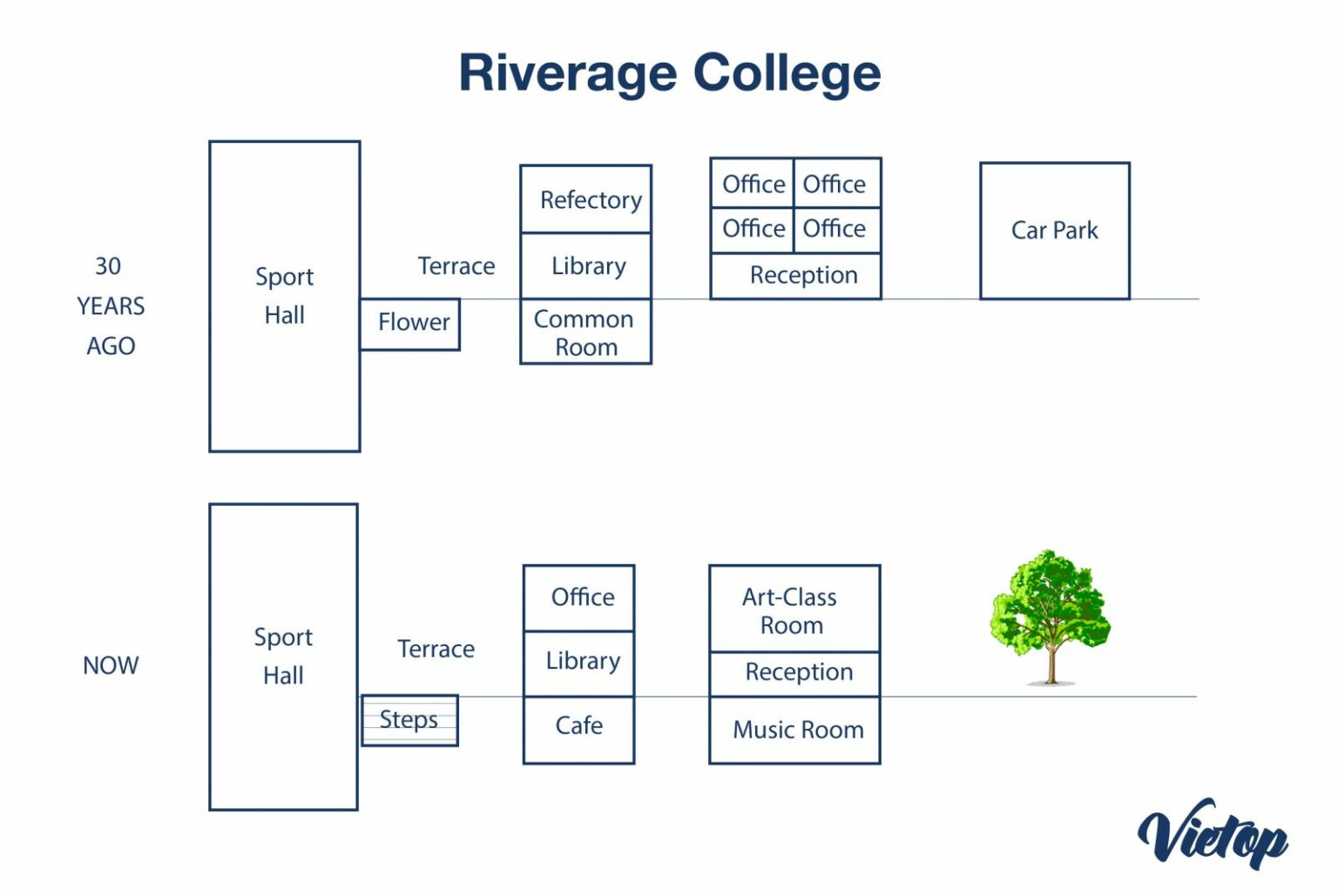
Sample answer
The maps provided illustrate how the architectural structure of Riverage College has changed over the last three decades, with two key features identified.
First of all, to the west, the sport hall & the terrace are still where they were 30 years ago, with no expansion. While the library became smaller and the reception room remains unchanged (in size and location) in the main building.
However, greater changes have taken place in a number of sections. Trees have replaced the car park in the east of the college, and instead of the common room and flowers on the ground floor, one now finds a coffee shop and a staircase respectively. In the main building, a music room has also been added right below the reception room. On the first floor, a huge art classroom is located in the space for the previous four offices, which have been combined into only one replacing the refectory adjacent to the library.
Overall, the general layout of the college has not changed significantly, but it looks more environment-friendly.
Bạn muốn chinh phục dạng maps và đạt điểm IELTS cao trong thời gian ngắn? Khóa luyện thi IELTS tại Vietop với lộ trình học tinh gọn, được thiết kế phù hợp với trình độ của từng học viên, giúp phát triển toàn diện kỹ năng IELTS.
Xem thêm: Hướng dẫn cách viết dạng Map – IELTS Writing Task 1
Ngày 08/04/2017
Task1: The pie charts provided illustrate two major changes in the use of modes of transport to a certain university between 2004 and 2009.
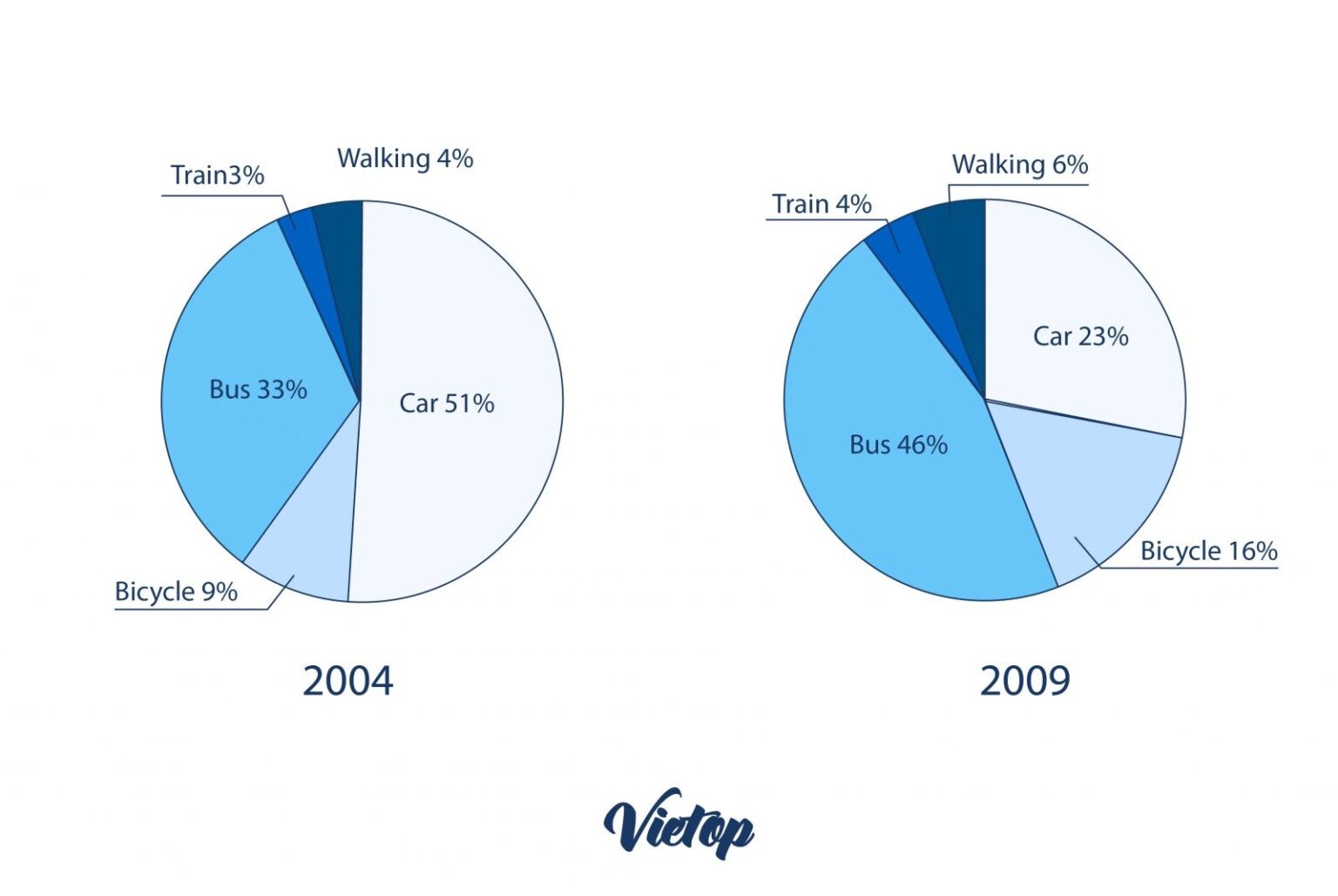
Sample answer
In the first place, the use of the car was the only one that had a downward trend, from 51% in 2004 to 28% in 2009 (a 23% decrease). This probably resulted from the fact that car parking began to be charged in the university in 2006. In contrast, travelling by using all the other means of transport had an upward trend. The most remarkable changes were in the use of the bus and the bicycle: a 13% and 7% rise respectively. One of the reasons was perhaps the year 2008 witnessed the appearance of a new bus stop in the university. The remaining two methods of transport also rose but insignificantly: by 2% (walking) and by 1% (train) only.
Overall, there were two contrasting trends of travelling to the university in the five-year period concerned.
Ngày 03/08/2017
Task 1: The chart and the graph show the number of new graduates and the their employment in the UK from 1992 to 2002.
- Đây là dạng đề 2 charts: 1 line graph + 1 bar chart.
- Line graph: số lượng sinh viên mới tốt nghiệp ở Anh Quốc trong giai đoạn 1992- 2002. Số liệu tăng từ 1992 đến 1997, sau đó giảm đến tận năm 2002. Nhìn chung, số liệu năm 2002 cao hơn năm 1992 (xu hướng chung là tăng).
- Bar chart: tỷ lệ công ăn việc làm (trong 5 nhóm ngành nghề) của những sinh viên mới ra trường ở 3 năm cụ thể là 1992, 1997 & 2002.
Có 2 xu hướng: tăng (3 nhóm sau) & giảm (2 nhóm đầu).
Sample answer
The provided charts indicate how many fresh college graduates there were in the UK during the 1992-2002 period and how they were employed in 1992, 1997 and 2002.
Overall, there was an increase in the number of graduates over the period while professional jobs dominated the other jobs in the job market for graduates.
First, the line graph shows only one trend: the number of new graduates fluctuated over the years. From 165,000 in 1992, this number soared to 195,000 five years later, followed by a drop lasting until 2002 (180,000). Compared with 1992, the year 2002 witnessed a 15,000-graduate increase.
Second, as seen in the bar chart, the employment rates indicate two different trends: upward and downward. A rise happened to clerical and secretarial positions (from 9% in 1992 to 19% in 2002), sales (4% up to 10%) and “other” jobs (7% up to 9%). A fall occurred to professional occupations (from nearly 60% to over 40%) and managerial and administrative jobs (20% down to 19%). Additionally, a large number of fresh graduates were employed in professional jobs in all the three years despite the decline, followed by managerial and administrative jobs, clerical and secretarial ones, sales & “other” jobs respectively.
Vocab items & Structures
- The given charts illustrate X: (= The provided charts indicate X / shed light on X / reveal some information about X)
- New graduates: sinh viên mới ra trường / mới tốt nghiệp ( = fresh graduates / new colllege graduates / fresh university graduates / people who just graduated from university / people who just finished college education)
Note: graduate students: học viên sau đại học (học viên cao học / nghiên cứu sinh)
- Their employment: tình hình công ăn việc làm của họ ( = their jobs / their occupations / how they were employed)
- An upward trend: Xu hướng tăng; ( = An increasing trend / a rising trend)
- A downward trend: Xu hướng giảm; ( = A decreasing trend / a falling trend / a dropping trend)
- To increase/rise to X%: tăng tới mức X%;
- To decrease/fall to X%: giảm tới mức X%;Note: To increase/decrease by X%: tăng/ giảm với mức X% ( = to increase/decrease X%);
- A rise/fall occurred to X: X tăng/giảm; ( = A(n) increase/decrease happened to X; X increased/decreased; X experienced positive/negative growth);
- To be employed in managerial jobs: Làm công việc quản lý; ( = To work as managers / to work in management)
- To account for X%: Chiếm tỷ lệ X%; ( = To make up X% / to comprise X%);
- Nearly X%: gần X%; ( = Almost X%);
- Approximately X%: khoảng X%; ( = roughly X%);
Xem thêm: Khóa học IELTS và luyện thi IELTS cấp tốc được nhiều bạn tại TPHCM theo học nhất – Cùng tìm hiểu ngay nhé!
Ngày 28/10/2017
Task 1: The percentage of 3 types of crimes: car theft, house burglary & street robbery in England & Wales from 1970 to 2015.
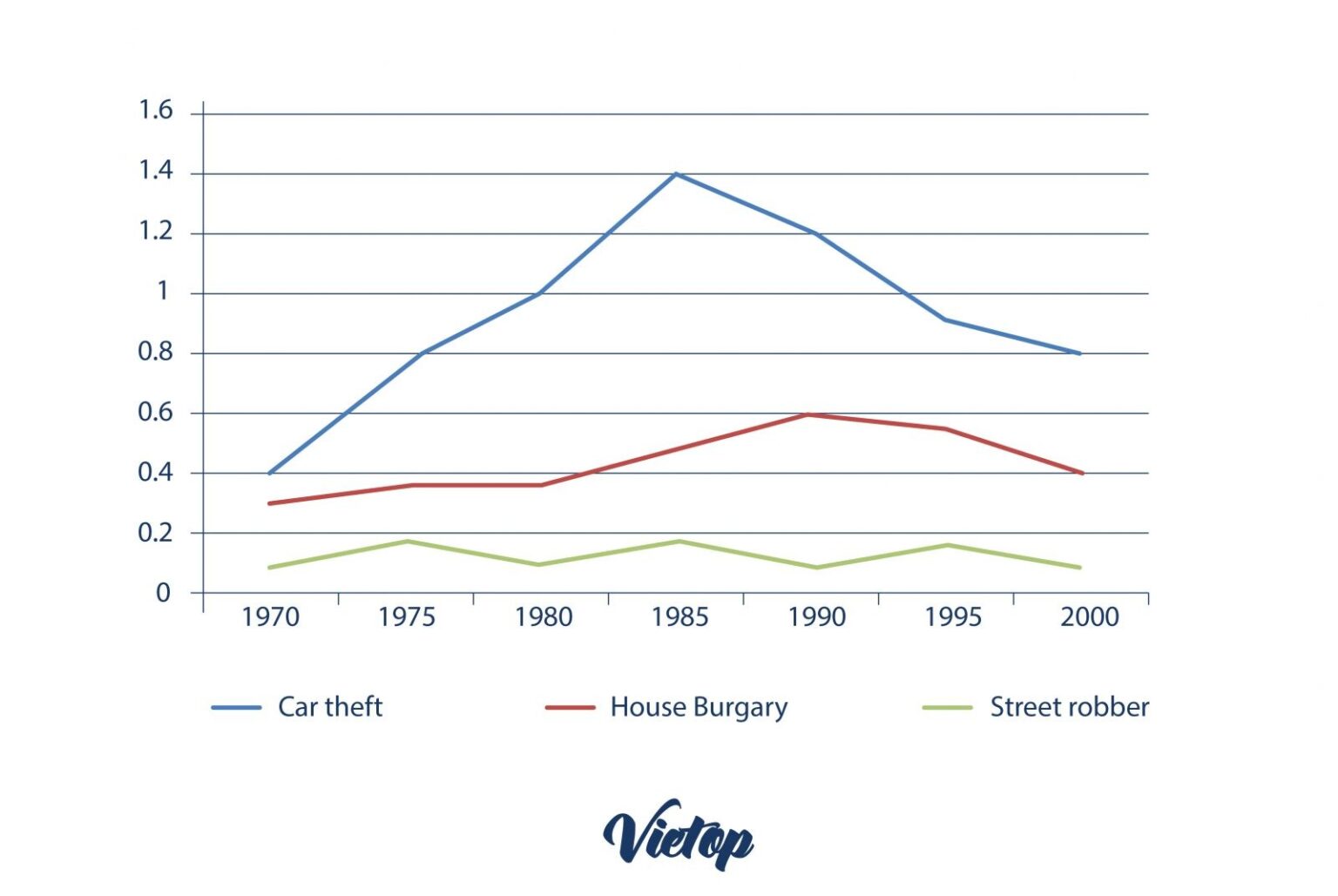
Chart analysis
Đây là dạng đề 1 line graph (về tỷ lệ phạm tội ở Anh & xứ Wales từ 1970 đến 2000). Có 3 lines: 1 line for car theft; 1 line for home burglary; 1 line for street robbery
Nhìn chung: tỷ lệ car theft là cao nhất suốt giai đoạn này, đồng thời tăng đáng kể nhất.
Cụ thể:
- Car theft: có dao động (đạt đỉnh là 1.4% năm 1985), nhưng xét cả giai đoạn là tăng từ 0.4% lên 0.8% (chênh lệch: 0.4%)
- Home burglary: cũng dao động (đạt đỉnh là 0.6% năm 1990), nhưng xét cả giai đoạn là tăng từ 0.3% lên 0.4% (chênh lệch: 0.1%)
- Street robbery: dao động không đáng kể, và xét cả giai đoạn là giảm từ 0.1% xuống chưa đầy 0.1%
Sample answer
The provided line graph shines light on how three kinds of crimes (namely, automobile thefts, home burglaries and street robberies) were committed in England and Wales during the 1970-2000 period. Overall, the percentage of car theft increased most significantly and was always higher than that of the other two crime categories.
Firstly, despite some fluctuations, the rate of street robberies did not change considerably over the years. From roughly 0.1% in 1970, this figure almost hit 0.2% in 1975, 1985 and 1995, but it eventually declined to slightly less than 0.1% in 2000.
However, the incidence of car theft and home burglary was much higher and generally experienced an upward trend over the thirty-year period. At first, they accounted for just 0.4% and 0.3% respectively in 1970, but rose by 0.4% and 0.1% in the same order in 2000, leaving the proportion of street robberies falling far behind. Specifically, they reached their peak at 1.4% in 1985 (the former) and at 0.6% in 1990 (the latter) before dropping back down.
Xem thêm:
13 cấu trúc “ăn điểm” trong IELTS Writing bạn không thể bỏ qua
Ngày 25/11/2017
Task 1: The pie charts below show information about where coffee is produced, consumed & where its profit goes.
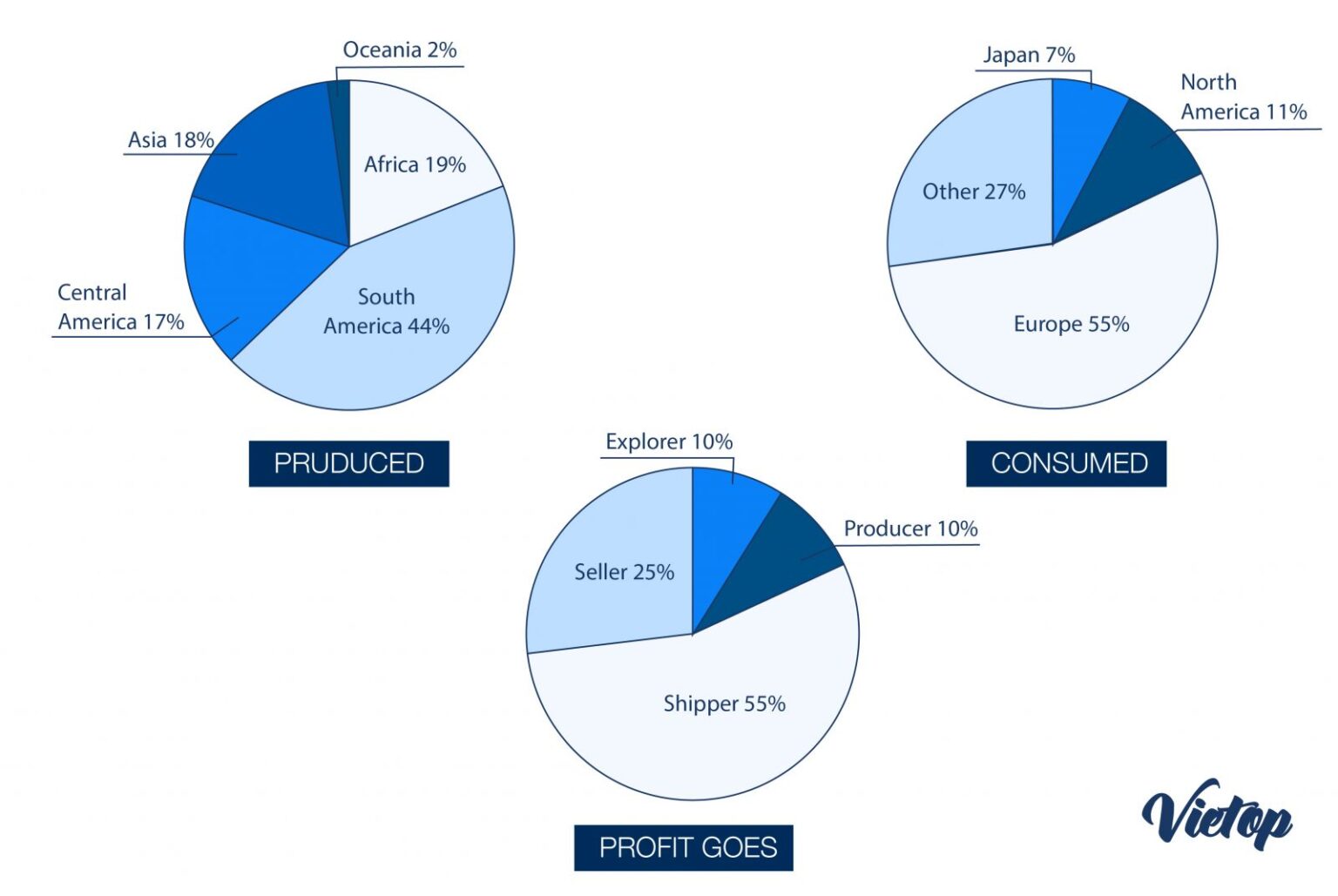
Chart analysis
- Đây là dạng đề pie charts (về tình hình sản xuất cà phê, tiêu thụ cà phê & lợi nhuận thu được)
- Có 3 pie charts: 1 chart for the production of coffee; 1 chart for the consumption of coffee; 1 chart for its profit distribution
- Nhìn chung: South America sản xuất nhiều nhất; Europe tiêu thụ nhiều nhất; shippers hưởng lợi nhiều nhất
Cụ thể:
- Về sản xuất: South America dẫn đầu (44%); 4 khu vực kia thấp hơn nhiều & thấp nhất là Oceania (2%).
- Về tiêu thụ: dẫn đầu là Europe (55%) & other regions/countries (27%); North America & Japan thấp hơn nhiều. Note: Đề chỉ ghi “other” nhưng khi viết phải diễn giải thành “other regions/countries” mới phù hợp với pie chart này.
- Về phân phối lợi nhuận: lợi nhuận chủ yếu vào túi shippers & sellers (tổng cộng là 80%); explorers & producers hưởng lợi rất ít (tổng cộng 20%).
Sample answer
The provided pie charts illustrate the production and consumption of coffee as well as the distribution of the profit concerned. Overall, South America is the most productive region, Europe is the greatest consumer, and shippers enjoy the highest amount of financial return.
Firstly, in terms of production figures, South America is the highest (44%), followed by Africa, Asia and Central America (19%, 18% and 17% respectively), leaving Oceania far behind (2%). As for consumption, the top two proportions are associated with Europe (55%) and other regions/countries (27%) whereas those of North America (11%) and Japan (7%) are much lower. Interestingly, Europe and North America do not produce coffee but their consumption is significant.
When it comes to profit earners, explorers and producers gain only 10% each while shippers and sellers are the greatest beneficiaries (55% and 25% in the same order). Again, those who sell and ship coffee products are not involved in the production process, but together they earn 80% of the total profit.
Bài mẫu IELTS Writing Task 2 năm 2017
Ngày 15/07/2017
Task 2: The animal species are becoming extinct due to human activities on land and in the sea. What are the reasons? What solutions to solve the issue?
Sample essay
It is brutally true that many members of the animal kingdom are dying out owing to human beings’ land-based and sea-based activities. Specifically, there exist three main causes of this phenomenon, which could hopefully be addressed in several ways.
Let us start with the detailed reasons. First, deforestation has detrimental effects on animal survival. Thousands of land animals, including elephants, lose their lives every year as a result of forest devastation for the purpose of building the so-called “civilized” resorts. Second, it is hunting that sadly contributes to the extinction of a wide range of animal categories.
A striking instance is the infamous hunting of whales by the Japanese, who are, ironically, living in a developed country with full awareness of environmental protection. Third, for geo-political reasons, certain nations are cruelly destroying the seas of neighbouring countries without any second thought. All these three factors result in sweeping many animal species from this planet.
Admittedly, there is no immediate solution to be applied once and for all, but this global problem could somehow be mitigated. Legally speaking, strict laws should be issued so as to harshly punish individuals or groups violating these laws through such activities as destroying forbidden forests, killing tigers for bones, or dumping rubbish into the sea.
From an educational standpoint, school subjects like biology should be taught and learnt following a more humane approach. This should be focused on developing students’ love and respect for animals in the broadest sense of the term, taking the importance of mutualism into account.
In a word, the three key causal factors have been identified, and legal as well as educational measures have been suggested for partially tackling the problem of extinction risk with which animals are faced.
Some vocab items:
- Many animal species: Nhiều loài động vật (= many members of the animal kingdom / many animal categories)
- To be becoming extinct: Sắp tuyệt chủng ( = to be dying out / to be coming (close) to extinction)
- To be becoming extinct: Sắp tuyệt chủng ( = to be dying out / to be coming (close) to extinction)
- Deforestation: (Nạn) phá rừng ( = forest destruction / forest devastation)
- Ironically: mỉa mai thay ( = in a way that is opposite to what is expected)
- Neighbouring countries: Các nước lân bang / láng giềng ( = adjacent countries)
- Admittedly, …: Phải thừa nhận rằng … ( = It must be admitted that …)
- Once and for all: Dứt điểm / dứt khoát 1 lần ( = completely)
- To mitigate X: Giảm độ trầm trọng của X ( = to alleviate X)
- Poverty alleviation/reduction: (Sự) giảm nghèo
- hunger eradication: (Sự) xóa đói
- To violate the law: (Vi) phạm luật ( = to break the law)
- To dump rubbish: Đổ rác ( = to remove / get rid of / dispose of garbage)
- a dump truck: Xe rác
- to dump one’s boyfriend/girlfriend: đá/xù (thằng/con) Bồ
- Humane: Có tính nhân văn/bản ( = showing sympathy/care/kindness towards others)
- human: (thuộc) Con người
- Mutualism: Hiện tượng cộng sinh / nương tựa vào nhau mà sống
- To tackle X: giải quyết X ( = to solve X / to resolve X / to deal with X / to handle X / to take care of X / to cope with X).
Some structures:
- It is brutally true that …: (Có 1) Sự thật phũ phàng là … ( = The brutal truth is that … / One of the brutal truths is that …)
- to X / because of X / as a result of X / on account of X / by virtue of X)
- There exist …: Có ( = There are …)There exists … = There is …
- It is X that sadly contributes to Y: Đáng buồn thay, chính X là nhân tố góp phần vào Y ( = X sadly contributes to Y)
- To result in X: Dẫn đến X ( = to lead to X / to lead up to X / to cause X)
- Legally speaking: Về phương diện pháp lý ( = in legal terms / from a legal perspective / from a legal viewpoint / from a legal standpoint)
- To harshly punish X: Phạt nặng X ( = to punish X harshly / to punish X severely / to severely punish X)
- To take X into account: (Có) xét đến X ( = to take X into consideration / to consider X)
- In a word: tóm lại ( = to sum up / to recap / in conclusion)
- To be faced with X: Đối diện X / đương đầu với X ( = to face X)
Hướng dẫn cách viết IELTS Writing Task 2
Ngày 30/9/2017
Task 2: The best way to reduce youth crimes is to educate their parents with parental skills. To what extent you agree or disagree?
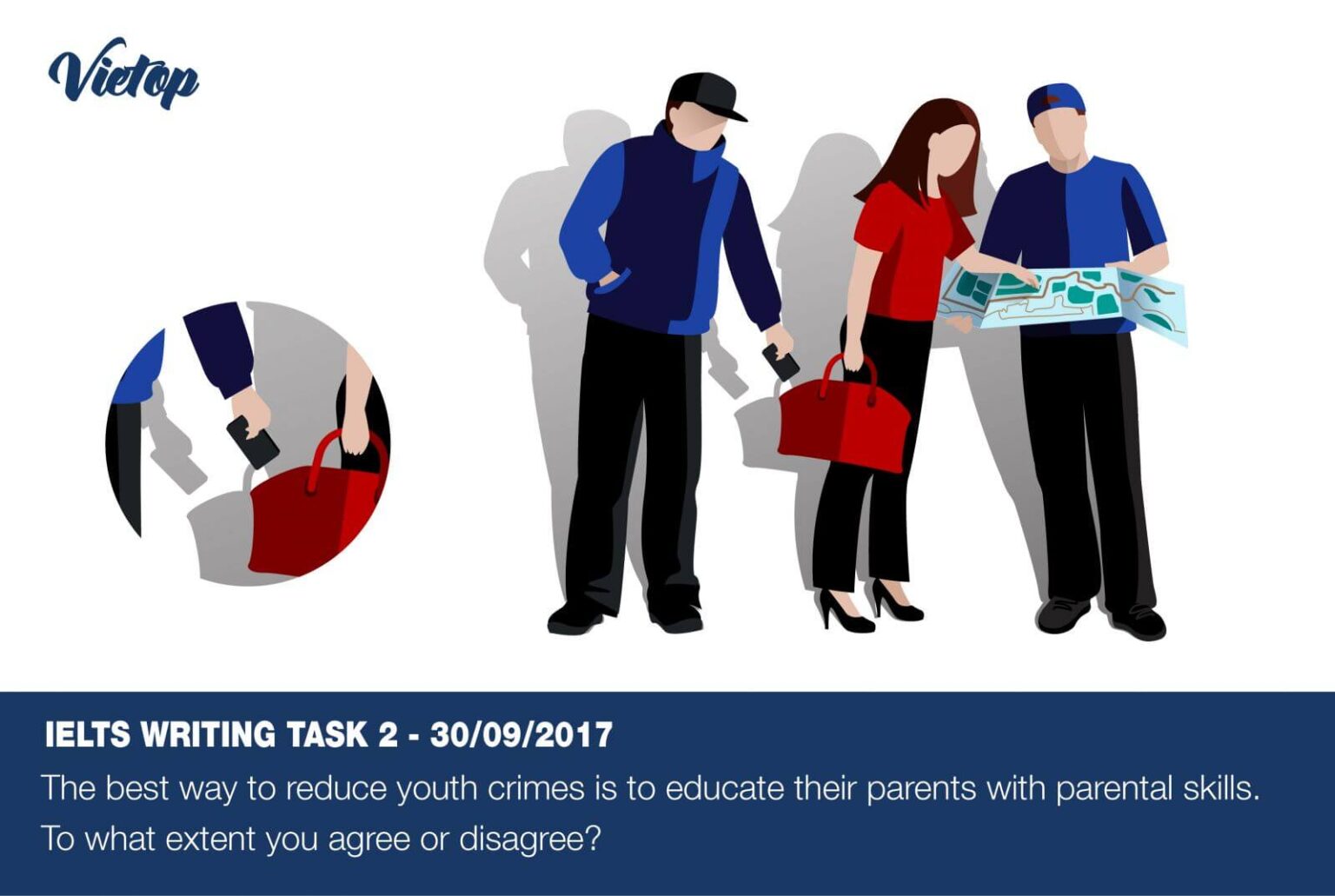
Note: Có thể chọn 1 trong 5 hướng (directions) sau:
- Cách tiếp cận totally agree;
- Cách tiếp cận totally disagree;
- Cách tiếp cận agree more than disagree;
- Cách tiếp cận disagree more than agree;
- Cách tiếp cận 50:50 (agreement = disagreement)
Topic analysis & Idea generation:
- Category (thể loại đề): Agreement/disagreement (Đồng ý / bất đồng)
- View (quan điểm luận bàn): Giải pháp tốt nhất để giảm tỷ lệ tội phạm ở giới trẻ là giáo dục cho các bậc phụ huynh kỹ năng làm cha làm mẹ
- Brainstorming / Idea generation (Chuẩn bị ý)
A. Nếu agree
- Parents, not schools, are to blame when children commit crimes => lack of skills to teach children how to distinguish right from wrong behaviours(Cha mẹ, không phải nhà trường, là những người chịu trách nhiệm chính khi con cái phạm tội => thiếu kỹ năng dạy bảo con cái phân biệt hành vi đúng sai)
- Parents, not the community, are excessively indulgent towards children => spoil children, who are likely to commit crimes
- (Cha mẹ, không phải cộng đồng, nuông chìu con cái quá mức => khiến con cái hư hỏng, dễ dẫn đến phạm tội)
- Parents are not technology-savvy => lack of skills to monitor children’s online activities
- (Cha mẹ không am tường công nghệ => thiếu kỹ năng giám sát những hoạt động trực tuyến của con cái)
- Parents do not understand children psychologically => lack of skills to listen to and advise children to avoid committing offences
- (Cha mẹ không hiểu tâm lý trẻ => thiếu kỹ năng lắng nghe và tư vấn cho con cái cách phòng tránh phạm tội)
B. Nếu disagree
- Youth crimes are caused by a variety of factors => it is hard to identify which is the main cause (Trẻ phạm tội là có nhiều nguyên nhân => khó xác định đâu là nguyên nhân chính)
- On a family level => instruct parents how to take care of kids in this information age(Từ góc độ gia đình => hướng dẫn cha mẹ kỹ năng dạy trẻ trong thời đại thông tin)
- On a school level => train teachers psychologically to tactfully deal with such problems as school violence(Từ góc độ nhà trường => huấn luyện thầy cô giáo về tâm lý trẻ để giải quyết khéo léo những vấn đề như bạo lực học đường)
- On a community level => organise many exciting activities to attract young people => provide a healthy outlet for their abundant energy(Từ góc độ cộng đồng => tổ chức nhiều hoạt động sôi nổi để thu hút giới trẻ tham gia => tạo điều kiện giải phóng năng lượng cho giới trẻ một cách lành mạnh).
C. Quick decision making (quyết định nhanh)
Chọn cách tiếp cận thiên về bất đồng (disagree more than agree).
Sample essay
Given the increasing rates of crimes committed by young generations in modern-day society, there are currently many suggested solutions, the most effective of which to lower these rates is said to be equipping fathers and mothers with parental techniques. To the best of my belief, such a view is far from convincing.
On the face of it, a number of adults probably lack certain skills in educating their children. They do not know how to teach their kids to distinguish right from wrong behaviours. They are not technology-savvy enough to prevent their children from online temptations. Consequently, such parents should be trained in how to discourage their kids from committing offences in this information age.
In actual fact, youth crimes result from various factors and, therefore, there is no single “best” way to deal with this problem. In order to effectively reduce criminal acts committed by the young, a combination of strategies involving parents, teachers and the community should be considered.
Apart from education for parents, teachers should also be psychologically trained so as to prevent or stop students from behaviours of violence or perversion on a daily basis.
For instance, specific training could be offered so that teachers would know exactly what to do to handle a case of bullying, one of the most common phenomena in the school context. On a community level, social groups should play a role in organizing fascinating activities, such as sports competitions, to attract young people, who frequently need an outlet for their abundant energy.
In short, I am not convinced by the suggestion that providing parents with child-care skills is the best method for youth crime reduction; rather, this requires efforts to be simultaneously made.
Ngày 02/12/2017
Task 2: Schools are no longer necessary because children can get information available through the Internet and thus they can study well at home To what extent do agree or disagree with this statement?

Topic analysis
- Category (thể loại đề): Agreement/disagreement (đồng ý / bất đồng);
- View (quan điểm luận bàn): Nhà trường không còn cần thiết nữa do trẻ có thể học tốt ngay tại nhà nhờ tiếp cận thông tin trên mạng Internet;
- Brainstorming / Idea generation (chuẩn bị ý)
Nếu agree
- Children can access many websites specializing in education => can learn the theory of & do exercises for all official grade-based subjects taught in primary & secondary school, such as maths, physics, chemistry, literature, biology, history, geography, etc. (Trẻ có thể tiếp cận nhiều trang web chuyên về giáo dục => học được lý thuyết & làm bài tập của tất cả những môn chính thống theo từng cấp lớp trong trường tiểu học & trung học, như toán, lý, hóa, văn, sinh, sử, địa, v.v.)
- Children can participate in many online forums that share a lot of additional information for school subjects => learn various problem-solving skills that are eye-opening (Trẻ có thể tham gia nhiều diễn đàn trên mạng chia sẻ thông tin bổ sung cho các môn học => học được kỹ năng giải quyết vấn đề, giúp trẻ mở rộng tầm mắt)
- Children can flexibly study & play games online => relieve stress & feel interested in learning activitie (Trẻ có thể linh động vừa học trên mạng vừa chơi game trực tuyến => giảm stress & có hứng thú trong học tập)
- Children can acquire self-study skills => develop skills for living independently & the lifelong learning habit (Trẻ học được kỹ năng tự học => hình thành kỹ năng sống tự lập & thói quen tự học suốt đời)
Nếu disagree
- Most children are overwhelmed & confused with the huge amount of information online => need school teachers to help select reliable sources (Đa phần trẻ bị choáng ngợp & lúng túng trước lượng thông tin khổng lồ trên mạng => Cần có thầy cô hướng dẫn chọn lọc những nguồn thông tin đáng tin cậy)
- Most parents are too busy to closely monitor their children => cannot guide their children in home self-study (Đa phần phụ huynh không có thời gian theo sát trẻ => không thể hướng dẫn trẻ cách tự học tại nhà)
- Most children tend to be addicted to online games => cannot concentrate on learning effectively (Đa phần trẻ mê chơi game trực tuyến => không thể tập trung học hiệu quả)
- Children are exposed to numerous risks online => adult films & stories, violence, cybercrime, etc. (Trẻ gặp phải vô vàn rủi ro trên mạng => phim & truyện người lớn, bạo lực, tội phạm, v.v.)
Note: Có thể chọn 1 trong 5 hướng (directions) sau:
- Cách tiếp cận totally agree
- Cách tiếp cận totally disagree
- Cách tiếp cận agree more than disagree
- Cách tiếp cận disagree more than agree
- Cách tiếp cận 50:50 (agreement = disagreement)
Quick decision making (quyết định nhanh): Chọn cách tiếp cận thiên về bất đồng (disagree more than agree).
Sample essay
It has recently been argued that schools no longer play an indispensable educational role as children can conduct successful Internet-based self-study in the home. Truth be told, I find this view unconvinving.
On the face of it, children today can certainly receive a great amount of information on the Internet whenever they wish to learn new things at home.
Since the advent of the World Wide Web, it has undeniably been easy for everyone, kids included, to undergo eye-opening experiences when they get online. Never in human history has there been such great access to so much information just with a click of the mouse.
However, it does not mean that all children using the Internet are able to teach themselves efficiently without school teachers.
Arguably, the vast majority of kids are actually in need of professional guidance from educators in how to select quality sources of information from the ocean of websites and how to get the best out of them.
More seriously, at a young age, most children are likely to be distracted from healthy learning activities by a wide variety of unhealthy online games, not to mention the harmful effects of adult materials in the virtual world that suddenly pop up on the computer screen while children are using the Internet.
Therefore, it could be said that children’s Internet use is one thing but learning effectively from its information sources is another.
In conclusion, despite children’s Internet access in today’s context, I hold the belief that schools still are, and will forever be, of the utmost importance in bringing academic success to children.
Some vocab items:
- Indispensable: Extremely important/necessary: Không thể thiếu
- At home: In the home: Ở nhà
- On the face of it: Superficially:Thoạt nhìn / nhìn bề ngoài
- Advent: Appearance / birth: Sự xuất hiện / sự ra đời
- Undeniably: Indisputably / unquestionably: Không thể phủ nhận
- Eye-opening experiences: Những trải nghiệm mở rộng tầm mắt
- Not to mention X: Đó là chưa nói đến X
- In today’s context: In today’s world / in modern-day society:Trong bối cảnh hiện nay
Some structures:
- To conduct successful Internet-based self-study: To teach oneself successfully based on the Internet (Tự học thành công nhờ vào mạng Internet)
- I find this view unconvincing: I am not convinced by this view / I find it hard to agree with this view (Tôi khó mà đồng ý với quan điểm này)
- Everyone, kids included: everyone, including kids (Mọi người, trong đó có trẻ em)
- Never in human history has there been such great access: there has never been such great access in human history (Trước giờ trong lịch sử nhân loại chưa từng có sự tiếp cận tuyệt vời đến thế)
Note: Cấu trúc đảo ngữ (inversion):
- X is in need of Y: X needs Y (X cần Y)
- X is one thing, but Y is another: X là 1 chuyện, còn Y thì lại là chuyện khác
Xem thêm: Khóa học IELTS online được nhiều bạn tại TPHCM theo học nhất – Cùng tìm hiểu ngay nhé!
Trên đây là tổng hợp các bài mẫu IELTS Writing 2017 Task 1 và Task 2. Vietop English hy vọng các bạn có thể tham khảo thêm nhiều cách viết IELTS Writing Task 1 và Task 2 để ôn luyện thật tốt cho kỳ thi IELTS. Chúc các bạn luyện thi IELTS hiệu quả và cùng đón chờ những bài viết mới nhất nhé!


![[ACE THE TEST] Giải đề IELTS Writing ngày 07/04/2025](https://vietop.edu.vn/wp-content/uploads/2025/04/giai-de-ielts-writing-ngay-07-04-2025.png)
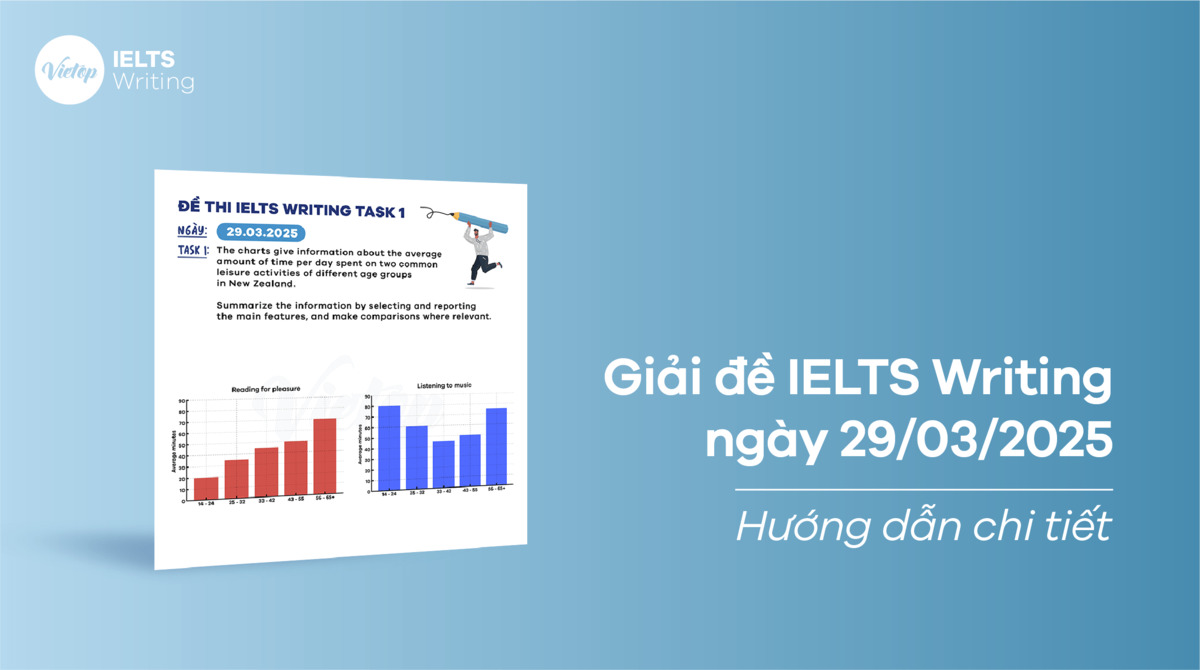
![[ACE THE TEST] Giải đề IELTS Writing ngày 15/03/2025](https://vietop.edu.vn/wp-content/uploads/2025/03/giai-de-ielts-writing-ngay-15-03-2025.jpg)
![[ACE THE TEST] Giải đề IELTS Writing ngày 22/03/2025](https://vietop.edu.vn/wp-content/uploads/2025/03/giai-de-ielts-writing-ngay-22-03-2025.jpg)
![[ACE THE TEST] Giải đề IELTS Writing ngày 08/03/2025](https://vietop.edu.vn/wp-content/uploads/2025/03/giai-de-ielts-writing-ngay-08-03-2025.jpg)
![[ACE THE TEST] Giải đề IELTS Writing ngày 06/03/2025](https://vietop.edu.vn/wp-content/uploads/2025/03/giai-de-ielts-writing-ngay-06-03-2025.jpg)
![[ACE THE TEST] Giải đề IELTS Writing ngày 22/02/2025](https://vietop.edu.vn/wp-content/uploads/2025/02/giai-de-ielts-writing-ngay-22-02-2025.jpg)
